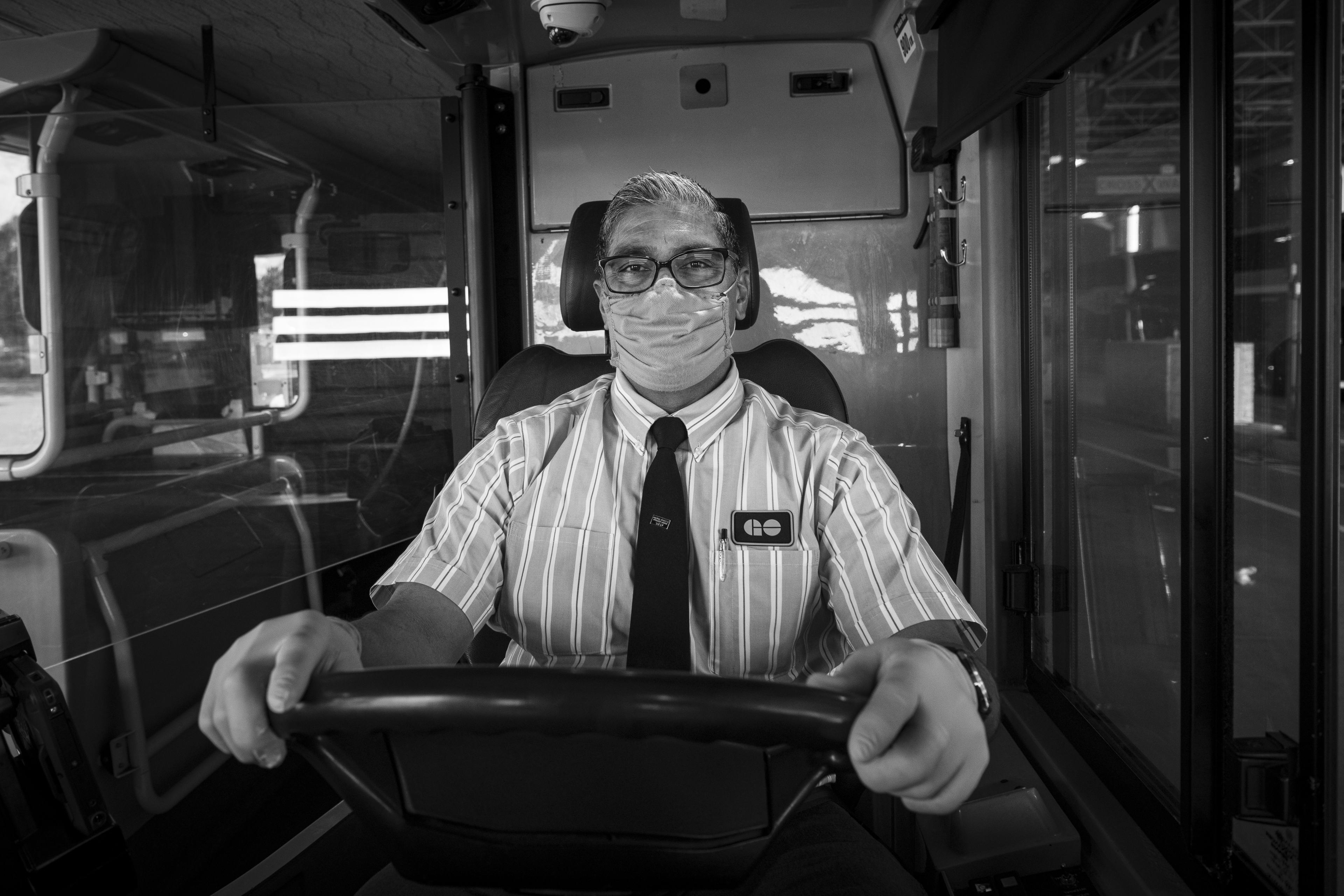How GO Transit business has continued throughout the pandemic
As Business Continuity Awareness Week begins, let's recognize how businesses run in hard times.
May 17, 2021
Many things have stopped, but Metrolinx and GO Transit have never paused during the ongoing pandemic.
Passengers have confidently gotten on board GO Transit trains and buses throughout the pandemic, knowing Metrolinx has implemented more than 40 safety actions across its network of GO Transit and UP Express vehicles, stations and platforms.
GO customer Britney Kisamo wears a non-medical face mask, in this file photo. (Lorne Bridgman photo)
Some of these actions are obvious to riders – like mandatory masks, polycarbonate barriers and constant surface cleaning – while others take place in the background, including employee health checks and upgraded ventilation. The transit agency’s success stems from an ability to react to a changing environment and a culture of business continuity planning that ensured Metrolinx was ready for anything.
Metrolinx and organizations around the world are currently marking Business Continuity Awareness Week (BCAW). It’s a time to learn more about the work that’s needed to prepare for a range of threats that could interrupt regular activities.
The theme this year is ‘Business Continuity Starts with You’.
“It reflects the culture and mindset of people at Metrolinx who are taking personal accountability,” said Paolo Raponi, a Metrolinx Business Continuity specialist.
Across Metrolinx, there are more than 60 business continuity plans. In early 2020, the annual review and maintenance process wrapped-up shortly before Ontario’s initial emergency declaration.
“A lot of risk mitigations and work around strategies were already in place and fortified to ensure continued safe reliable service,” said Shannon Colquhoun, a Metrolinx senior advisor for Business Continuity.
Throughout the pandemic Colquhoun has led virtual meetings with Business Continuity leads across the organization and coordinated their efforts with the COVID-19 Incident Command Team.
“On these calls, they spoke about the challenges they were facing, shared ideas and helped each other to find solutions,” Colquhoun explained.
Throughout the pandemic, Metrolinx has been in constant contact with its vendors about their plans, to make sure there is a steady supply of everything needed to keep trains and buses running on time – the most visible being personal protective equipment (PPE).
“All of our frontline staff were issued a suite of PPE, with face coverings, medical masks, sanitizer, gloves and face shields,” said Anthony Pezzetti, a senior manager for Bus Operations.
A Natsco Transit Solutions worker assembles part of a seat divider inside a GO train coach. In addition to seat divider, Metrolinx is also installing more than 3,700 hand sanitizer dispensers to each entry zone of our train fleet. (Matt Llewellyn photo)
Passengers have noted the arrival of polycarbonate shields between seats, additional hand sanitizers on board trains and buses, new phone cleaners in stations and colourful stickers showing people how to maintain distance. Seat reconfigurations on buses also helped with spacing.
“Instead of having to try and establish a maximum capacity number, we established physical controls that provided distancing between customers,” Pezzetti said.
Staff were reassigned from other duties to provide additional cleaning on vehicles. For example, Metrolinx worked with the Amalgamated Transit Union to redeploy bus drivers and station attendants for this.
“We initiated a midday cleaning program, cleaning that occurred on layovers, wiping grabrails, handlebars, PRESTO machines and anything else a customer might touch, to keep them as clean as possible,” Pezzetti said.
From the start, Metrolinx protocols were so strong that provincial authorities asked for GO buses to take on two early challenges. In May 2020, they were used to distribute COVID-19 testing supplies to select community centres and health care centres in Peel Region. Then, in July, a convoy of GO buses transported 300 migrant workers, who had just finished two weeks of self-isolation, from hotels to their work locations located in Leamington.
The selection of GO for this work demonstrates the safety of its vehicles.
The measures seen by riders are in addition to work behind the scenes. If you were to visit working areas, like the garages, you would see everybody wearing a wristband. That’s because employees and visitors are screened and given a temperature check when they arrive, before being given a wristband to prove that they passed.
“When in these very important facilities, it’s an indicator that you’ve been checked and are clear to go through the area,” Pezzetti said.
Wristbands are also used at the Network Operations Centre (NOC) which serves as the nerve centre for day-to-day dispatching and coordinating of Metrolinx vehicles. It is important work and the people who do it absolutely must stay healthy. Rapid testing was also implemented.
“The NOC employees couldn’t work from home, so we needed a strategy, physical separations and use of PPE,” said Vito Mangialardi, who wears two hats at Metrolinx – COVID-19 incident commander and as senior manager for Business Continuity.
Mangialardi and the Business Continuity Office are working to build a culture across Metrolinx that is constantly anticipating challenges and planning ahead.
“Business continuity has moved into the operational framework of managers, so when they see issues, they are creating proactive strategies to ensure that the integrity of our operations is always maintained,” Mangialardi said.
In recent weeks, Metrolinx business continuity work has been recognized internationally twice.
First, on April 29, Mangialardi was named Continuity and Resilience Professional for the Public Sector in 2021 in the Business Continuity Institute (BCI) Americas Awards.
This week, a case study outlining efforts to build a resiliency culture at Metrolinx appears on the BCI website.
Metrolinx employees are keeping vehicles safe, day in and day out, and the work to build an adaptable culture, which started long before the pandemic, will continue to make sure Metrolinx is ready to face the future.
Interested in Metrolinx’s COVID safety measures? Here’s another story below.
by Mike Winterburn Metrolinx communications senior advisor
